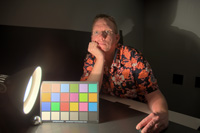 Last August, Prof. Mark D.Fairchild, Professor of Color Science and Director of the Munsell Color Science Laboratory in the Chester F. Carlson Center for Imaging Science at the Rochester Institute of Technology released an image database for research in High-Dynamic-Range (HDR) imaging. This database is called the HDR Photographic Survey.
Last August, Prof. Mark D.Fairchild, Professor of Color Science and Director of the Munsell Color Science Laboratory in the Chester F. Carlson Center for Imaging Science at the Rochester Institute of Technology released an image database for research in High-Dynamic-Range (HDR) imaging. This database is called the HDR Photographic Survey.
In these days, when camera sensors have a bit depth of 12 or 14 bits and LCD panels are at 12 bits, developing good compression and rendering algorithms for HDR images is increasingly important. Also, most SLR cameras nowadays feature automatic exposure bracketing, so it is relatively easy to create HDR images. The problem is having well characterized reference images that everybody can use, so algorithms can be compared.
One aim of Prof. Fairchild's HDR Photographic Survey is to provide such images in the public domain to researchers working on HDR systems and perception with a key feature being the inclusion of camera characterization data to allow conversion to accurate device-independent image data, colorimetric measurements of original scene elements, color appearance scaling of scene elements, and other scene data allowing increased utility of the images.
There are 106 images in all. Twenty-eight have accompanying colorimetric and appearance data. The remaining images have various data associated with them, but as a minimum have an absolute luminance calibration. The link is http://www.cis.rit.edu/fairchild/HDR.html.
The images are saved as OpenEXR files. The OpenEXR format retains the image data as 32-bit floating-point values. These minimally-processed — and photometrically linear — OpenEXR files are what is available in the database. Each HDR image retains a dynamic range of about 800,000:1 (19-20 stops, or bits, of real image information).
The advantages of knowledge of the original scenes, both direct and through the appearance scaling and colorimetric data, cannot be overstated. It is already evident that having such data combined with HDR images can greatly enhance research on human visual perception and imaging techniques.
Image content includes many natural landscapes, but also portraiture and indoor/outdoor scenes of man-made objects. Lastly, some extra images are also available that are simply nice photographs.
The database images and data are in the public domain for research purposes. It is only requested that they not be reproduced for commercial purposes and that the source of the images be acknowledged in any publications or presentations resulting from research in which they are used.
 The study was done at the Neuroeconomics Lab at the University of Bonn located at the Life&Brain Research Center by Dr. Armin Falk and his co-workers and is reported in the 23 November 2007 issue of Science, Vol. 318. no. 5854, pp. 1305 - 1308 in the paper
The study was done at the Neuroeconomics Lab at the University of Bonn located at the Life&Brain Research Center by Dr. Armin Falk and his co-workers and is reported in the 23 November 2007 issue of Science, Vol. 318. no. 5854, pp. 1305 - 1308 in the paper 


